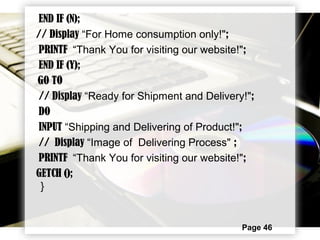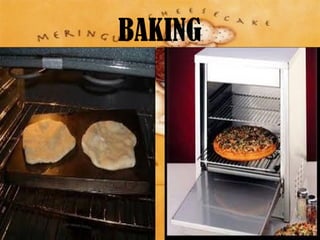COMPUTER PROGRAMMING
- 1. Page 1 CHAPTER 9 (Computer Programming)
- 2. Page 2 PROGRAMMING • Programming or coding is the process of designing, writing, testing, debugging / troubleshooting, and maintaining the source code of computer programs. • This source code is written in a programming language. The code may be a modification of an existing source or something completely new.
- 3. Page 3 PURPOSE OF PROGRAMMING • The purpose of programming is to create a program that exhibits a certain desired behaviour (customization). • The process of writing source code often requires expertise in many different subjects, including knowledge of the application domain, specialized algorithms and formal logic.
- 5. Page 5 QUALITY REQUIREMENTS • Whatever the approach to software development may be, the final program must satisfy some fundamental properties. • The following properties are among the most relevant:
- 6. Page 6 EFFICIENCY / PERFORMANCE • Is the amount of system resources a program consumes (processor time, memory space, slow devices such as disks, network bandwidth and to some extent even user interaction): the less, the better. • This also includes correct disposal of some resources, such as cleaning up temporary files and lack of memory leaks .
- 7. Page 7 RELIABILITY • Is how often the results of a program are correct. • This depends on conceptual correctness of algorithms, and minimization of programming mistakes, such as mistakes in resource management (e.g., buffer overflows and race conditions) and logic errors (such as division by zero or off-by-one errors).
- 8. Page 8 ROBUSTNESS • Is how well a program anticipates problems not due to programmer error. • This includes situations such as incorrect, inappropriate or corrupt data, unavailability of needed resources such as memory, operating system services and network connections, and user error.
- 9. Page 9 USABILITY • Is the ergonomics of a program: the ease with which a person can use the program for its intended purpose, or in some cases even unanticipated purposes. • Such issues can make or break its success even regardless of other issues. • This involves a wide range of textual, graphical and sometimes hardware elements that improve the clarity, intuitiveness, cohesiveness and completeness of a program's user interface.
- 10. Page 10 PORTABILITY • Is the range of computer hardware and operating system platforms on which the source code of a program can be compiled/ interpreted and run. • This depends on differences in the programming facilities provided by the different platforms, including hardware and operating system resources, expected behavior of the hardware and operating system, and availability of platform specific compilers (and sometimes libraries) for the language of the source code.
- 11. Page 11 MAINTAINABILITY • Is the ease with which a program can be modified by its present or future developers in order to make improvements or customizations, fix bugs and security holes, or adapt it to new environments. • Good practices during initial development make the difference in this regard. • This quality may not be directly apparent to the end user but it can significantly affect the fate of a program over the long term.
- 13. Page 13 DEBUGGING • Debugging is a very important task in the software development process, because an incorrect program can have significant consequences for its users.
- 14. Page 14 CONTINUATION: • Some languages are more prone to some kinds of faults because their specification does not require compilers to perform as much checking as other languages. • Use of a static analysis tool can help detect some possible problems • Debugging often provide less of a visual environment, usually using a command line.
- 15. Page 15 PROGRAMMING LANGUAGES • Different programming languages support different styles of programming (called programming paradigms ).
- 16. Page 16 • The choice of language used is subject to many considerations, such as company policy, suitability to task, availability of third-party packages, or individual preference. • Ideally, the programming language best suited for the task at hand will be selected. Trade-offs from this ideal involve finding enough programmers who know the language to build a team, the availability of compilers for that language, and the efficiency with which programs written in a given language execute. CONTINUATION:
- 17. Page 17 BASIC SYNTAX IN PROGRAMMING LANGUAGES
- 18. Page 18 INPUT • Means - Get data from the keyboard, a file, or some other device.
- 19. Page 19 OUTPUT • Means - Display data on the screen or send data to a file or other device.
- 20. Page 20 ARITHMETIC • Means - Perform basic arithmetical operations like addition and multiplication. • Also known as COMPUTER ALGORITHM
- 21. Page 21 CONDITIONAL EXECUTION • Means - Check for certain conditions and execute the appropriate sequence of statements. • By using the flow chart
- 22. Page 22 REPETITION • Means - Perform some action repeatedly, usually with some variation.
- 23. Page 23 THE ALGORITHM FLOW CHART
- 24. Page 24 FLOW CHART • Is a type of diagram, that represents an algorithm or process , showing the steps as boxes of various kinds, and their order by connecting these with arrows.
- 25. Page 25 FLOW CHART • This diagrammatic representation can give a step-by-step solution to a given problem. • Data is represented in these boxes, and arrows connecting them represent flow / direction of flow of data. • Flowcharts are used in analyzing, designing, documenting or managing a process or program in various fields
- 26. Page 26 4 GENERAL TYPES FLOW CHART • Document flowcharts, showing controls over a document-flow through a system • Data flowcharts, showing controls over a data flows in a system • System flowcharts showing controls at a physical or resource level • Program flowchart, showing the controls in a program within a system
- 27. Page 27 FLOW CHART SYMBOLS The Basic Types of Flow Chart Symbols • Start and End Symbols • Arrows • Processing Steps • Input / Output • Conditional or Decision
- 28. Page 28 START AND END SYMBOLS • Is represented as circles, ovals or rounded rectangles, usually containing the word "Start" or "End", or another phrase signaling the start or end of a process, such as "submit enquiry" or "receive product" END STARTSTART
- 29. Page 29 ARROW SYMBOLS • Is showing what's called "flow of control" in computer science. • An arrow coming from one symbol and ending at another symbol represents that control passes to the symbol the arrow points to. FLOW OF DIRECTION
- 30. Page 30 PROCESSING SYMBOLS / STEPS • Is Represented as rectangles. • It also represents any process, function, or action and is the most frequently used symbol in flowcharting DO SOMETHING
- 31. Page 31 INPUT AND OUTPUT SYMBOLS • Is represented as a parallelogram to display the Input and Output in program. INPUT OUTPUT
- 32. Page 32 CONDITIONAL OR DECISION SYMBOL • Is represented as a diamond (rhombus). • These typically contain a Yes/No question or True/False test. • This symbol is unique in that it has two arrows coming out of it, DECISION
- 33. Page 33 CONDITIONAL OR DECISION SYMBOL • usually from the bottom point and right point, one corresponding to Yes or True, and one corresponding to No or False. The arrows should always be labeled. • A decision is necessary in a flowchart. More than two arrows can be used, but this is normally a clear indicator that a complex decision is being taken, in which case it may need to be broken-down further, or replaced with the "pre-defined process" symbol.
- 34. Page 34 CONNECTOR SYMBOL • Is represented as circle. • To rejoin or attach the arrow symbol for the flow of direction CONNECT
- 35. Page 35 EXAMPLE OF FLOWCHART PROCESS STARTSTART MIX THE INGREDIENTS HOME CONSUMPTION ONLY PACKAGING, CARTONING/PALLETIZING KNEADING, PROOFING , BAKING ORDER? STOPSTOP Yes No SHIPPING / DELIVER THE PRODUCT
- 37. Page 37 TURBO C PROGRAMMING • Turbo Basic is a BASIC compiler and dialect originally created by Robert "Bob" Zale and bought from him by Borland.
- 38. Page 38 TURBO C PROGRAMMING • This software is from the 1987- 1988 period and features the Borland "black screen" similar to Turbo Pascal 4.0, Turbo C 1.0/1.5, and Turbo Prolog 1.1.
- 39. Page 39 CONTINUATION • Borland did not adopt its trademark "blue screen" integrated development environment until the 1989 period when Turbo C 2.0, Turbo C++ 1.1, etc. were released. By this time, Turbo Basic and Turbo Prolog were no longer being sold. • Unlike most BASIC implementations of this period, Turbo Basic was a full compiler which generated native code for MS-DOS.
- 40. Page 40 TURBO C PROGRAM SYNTAX
- 41. Page 41 • Basic command list #INCLUDE <STDIO.H> = Standard Input / Output { } = Cover of programs (start and Ends) ; = command function at the end of message CLRSCR (); PRINTF = display message ( INPUT QUESTIONS) IF = (Conditional commands) END IF / ELSE IF = (Conditional commands) SCANF = scanning of output response DO = process INPUT = process // Display = output response after the process LOOP = go back to previous NEXT = proceed to next process GO TO = proceed to specific input / command GETCH (); = End of program
- 42. Page 42 • EXAMPLE: TURBO C PROGRAM #INCLUDE <STDIO.H> MAIN { CLRSCR (); PRINTF ("Hit any key to continue: "); // Wait for a key press, flashing the message // “Welcome to Marianne’s Baking Business“; on and off once per second. // After any key is hit, display “(Y)!" ; // After any key is hit, display “(N)!" ; INPUT “Y / N”; SCANF (“Where Y = Yes, Where N = No");
- 43. Page 43 IF (N); LOOP PRINTF "Goodbye "; IF (Y); // Display “First Step: Mixing of Ingredients!" ; DO INPUT “Mixing of Ingredients"; // Display “Image of End Product" ; NEXT 2 INPUT “Y / N”; SCANF (“Where Y = Yes, Where N = No"); IF (N); LOOP PRINTF "Goodbye ";
- 44. Page 44 IF (Y); // Display “Second Step: Kneading, Proofing and Baking!" ; DO INPUT “Kneading, Proofing and Baking Process"; // Display “Image of End Product" ; NEXT 3 INPUT “Y / N”; SCANF (“Where Y = Yes, Where N = No"); IF (N); LOOP PRINTF "Goodbye "; IF (Y); // Display “Third Step: Packaging, Cartoning and Palletizing!" ;
- 45. Page 45 DO INPUT “Packaging, Cartoning and Palletizing Process"; // Display “Image of End Product" ; NEXT 4 INPUT “Y / N”; SCANF (“Where Y = Yes, Where N = No"); IF (N); LOOP PRINTF "Goodbye "; IF (Y); // Display “Is there any order?"; NEXT 5 INPUT “Y / N”; SCANF (“Where Y = Yes, Where N = No");
- 46. Page 46 END IF (N); // Display “For Home consumption only!"; PRINTF “Thank You for visiting our website!"; END IF (Y); GO TO // Display “Ready for Shipment and Delivery!"; DO INPUT “Shipping and Delivering of Product!"; // Display “Image of Delivering Process" ; PRINTF “Thank You for visiting our website!"; GETCH (); }
- 48. Page 48 PRESS ANY KEY TO CONTINUE Y N
- 49. Page 49
- 50. Page 50
- 51. Page 51
- 53. Page 53 MIXING OF INGREDIENTS
- 54. Page 54
- 55. Page 55
- 56. Page 56 KNEADING
- 57. Page 57 PROOFING
- 58. Page 58 BAKING
- 59. Page 59
- 60. Page 60
- 61. Page 61 PACKAGING, CARTONING AND PALLETIZING
- 62. Page 62
- 63. Page 63
- 64. Page 64
- 65. Page 65
- 66. Page 66
- 67. Page 67 SHIPPING AND DELIVERING
- 68. Page 68




































































